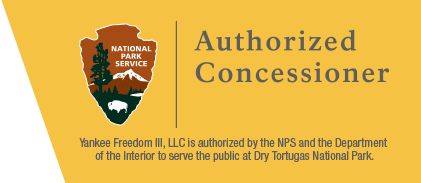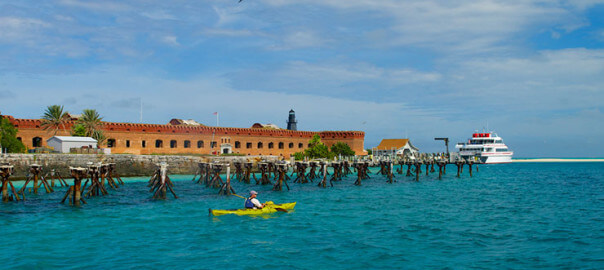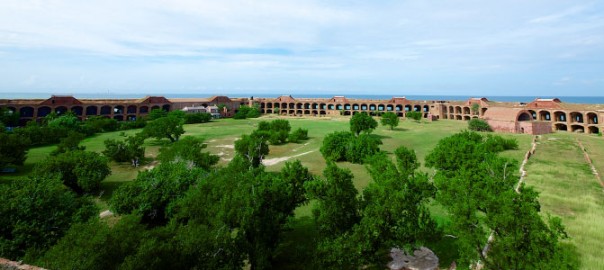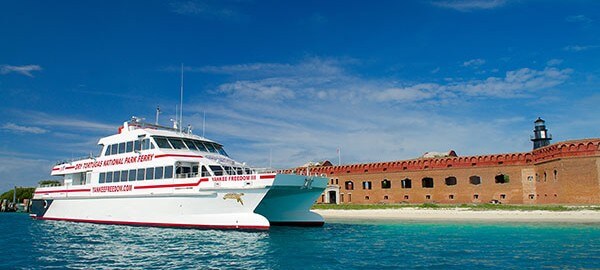A Forgotten Fort At the End of Nowhere
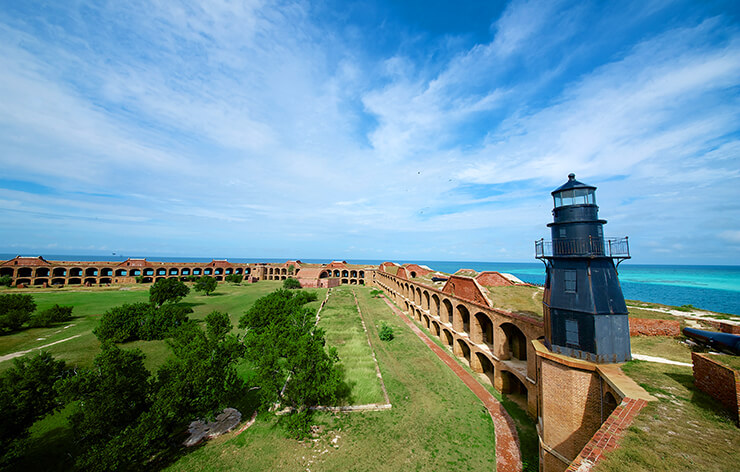
New York Times
By MICHAEL CONNOR
Published: November 20, 1988
BEYOND the glitter of Miami and the party lights of Key West there is a bit of America that borders on nowhere. At first sighting on a sunlit day in the Dry Tortugas, Fort Jefferson rises from the sea like a specter from a dark fable.
Big enough for 1,500 people and 450 cannons, the fort has six plain-to-see sides, a moat and walls thicker than most humans are tall. No man, the logical mind says even before all this tangible evidence, could have built anything of such mass and obvious uselessness in a place so remote. Think of the money. The labor. The time.
But on a tiny coral reef 70 miles beyond the westernmost tip of Key West, the United States Army Corps of Engineers did indeed construct the fort, which was meant to counter America’s 19th-century European rivals by giving the United States sway over the Gulf of Mexico. More than three decades and 16 million bricks, as well as many lives, went into the venture.
The fort never saw military action, was outmoded before nearing completion, and is best known as the hellish prison to which Dr. Samuel Mudd was dispatched for treating President Lincoln’s fleeing assassin, John Wilkes Booth. Since 1935 the crumbling, red-brick fort and the surrounding 100 square miles have been part of the National Park system, little known and little visited.
The reason is simple: its remoteness. Set down off the end of Florida like an afterthought, the Dry Tortugas, marked Dry by map makers as a warning that no potable water was to be found, have always been difficult to reach.
The Marquesas Keys, an atoll with manes of lush mangroves, was the first landmark. The atoll is the only one in the Atlantic.
Coming upon the fort in so remote a place was like seeing a pyramid in the Arctic.
The construction of Fort Jefferson began in 1846, but planning for it and a chain of coastal forts from Maine to Texas had started after the War of 1812. The expanding United States grew ever more wary of Europe’s great powers. As early as 1829, it was clear to the United States military that the Dry Tortugas, centered at the watery crossroads of the Gulf of Mexico, offered the United States or some other nation control of shipping in the region.
The first workers were slaves from Key West and laborers and craftsmen from the North, including many Irish immigrants. Most of the workers are forgotten, but one of the Irishmen, a master bricklayer named J. N. O. Nolan, etched his name in several places within the fort. And his graffiti looked as fresh to us as when he wrote them before the Civil War.
The work went on intermittently for three decades. Wavering funds, disease, hardship, engineering missteps and advances in military technology all interfered with the work. Like the people, every item had to be imported. Bricks from the north, wood from Louisiana and nails from Pennsylvania. Only some of the makings for mortar were found in the Tortugas, on Bush Key 50 yards from the fort. First, foundations 2 feet deep and 14 feet wide were put down on what was believed to be solid coral to support the massive walls of the fort, named for Thomas Jefferson. In reality, the coral was further down and the foundations were laid on shifting sands that would cause the massive brick walls to settle and crack. Eventually, a moat, magazines for ammunition and officer quarters were added but Fort Jefferson was never completed. Even so, it encompasses a half mile and remains the biggest brick fort in the Western Hemisphere, according to the National Park Service.
Living on the Tortugas was very hard. The first break for freedom was by seven slaves in 1847, just months after they arrived, and many others followed. Food was difficult to obtain and sometimes infested with vermin, water often brackish, entertainment nearly nonexistent and outbreaks of yellow fever killed dozens. Things got so dreary that serious shortages of workers developed and President Lincoln took to offering condemned men pardons for a year’s hard labor at Fort Jefferson.
Soon, what had been envisioned as ”the Gibraltar of the Gulf” had a reputation as the Devil’s Island of the North.
”No drill on account of the heavy guard,” a guard at the fort, Sgt. Harrison Herrick of the 110th New York Volunteers, wrote in his diary on May 6, 1864.
”In the morning, while the prisoners on ‘Thames’ were coming ashore, one of the guards, one of the First Delaware Artillery, shot himself through the head. He was crazy. Weather fair and pleasant.”
Dr. Mudd was by far the most famous prisoner at Fort Jefferson, and he too made an unsuccessful escape attempt. He was pardoned after four years for treating prisoners and guards struck down during the fort’s worst outbreak of yellow fever, in 1867, when the staff physician, 4 nurses and 34 others died.
No shots were ever fired at the fort. The only episode resembling combat came very early during the Civil War. Before the Union could install cannons at the fort, it stationed troops there who were confronted by a rebel ship demanding surrender.
”Tell your captain,” a Union major, L. G. Arnold, told a rebel messenger standing before the fort’s imposing front wall, ”I will blow his ship out of the water if he’s not gone in 10 minutes.” The bluff worked and Union cannons arrived a few months later.
By 1874 all work had stopped, all prisoners were gone and Fort Jefferson was officially abandoned. No European power had ever attacked, the great engineering feat had been only partly accomplished, and the fort’s walls were no longer impregnable since the invention of rifled artillery in the Civil War. The brick fort had been doomed from the start, and proven to be a grand white elephant of a different hue.
Today the walls meant to uphold the Monroe Doctrine are crumbling. The National Park Service staffs the fort, the surrounding keys and coral reefs comprising the Fort Jefferson National Monument with 10 rangers. They leave visitors to explore on their own the artillery rooms, ammunition storerooms and moat.
There are 10-inch cannons, and gun racks and a grassy interior with trees like those at many other military monuments. But when we climbed into the great fort’s walls, we walked into the heart of the place. Room after room, meant to house cannons and safeguard defenders, is connected by rows of arches like those at an ancient monastery.
The rooms have single windows meant for the cannon barrels and elaborate racks for arming and manipulating the big guns.
Much of the brickwork in the cannon rooms has been eaten away by weather, sea spray and, to some extent, the sonic booms trailing American fighter planes in training for 20th century conflict.
As we passed from room to room, the vista of bright skies, nearby keys and sparkling turquoise sea changed constantly. First, a view of the moat and the lighthouse on Loggerhead Key. Then a portrait through a grillwork of deteriorating brick of a Magnificent Frigatebird motionless in an updraft. Walking on, there was Bush Key and a few sooty terns milling about against clouds capable of inspiring rhapsody. Perhaps it is the futility of the great labor and hardships or the distance from the everyday, but the play of bright sunlight, cool shadows and sober architecture meant to stand for the ages suggested a great church as much as a great fort. There is silence and solitude and a sense of wonder inherent in the remote place. And, in one of Fort Jefferson’s six bastions, protruding strong points in the walls designed to create broad killing zones for defenders, there is a room known as ”the Chapel.”
The brickwork is especially fine, the mortar painstakingly laid and together they reflect the attentions of master workmen.
Tradition has it that this unlikely place, with its vaulting ceilings, arches and thick pillars, was where the soldiers and workers and prisoners and slaves worshiped.
A small campground, mostly heavily used during the Tortugas’ stunning spring birding season in March, April and May can be seen, as well as a swimming beach and an area for snorkeling, which is excellent.
Birders come to the islands to see the more than 300 land species migrating through and the nesting of seabirds. Bush Key, barely larger than a suburban parking lot, fills up during the breeding season with as many as 100,000 terns. Along the moat walls, one can walk between the Gulf and the shallow moat waters where, when government money is available, baby sea turtles are nursed for their first year.
But it is within those walls where the silence and remoteness and vigor of the Dry Tortugas are most pronounced.
And it is inside those walls where the lapping of the Gulf’s waters against Fort Jefferson’s immense walls can be heard, murmuring that nature will reclaim the great fort for itself.
The Tortugas get only 25,000 visitors a year, and it is one of the least used National Park sites.
Information about the Fort Jefferson National Monument can be obtained from Superintendent of Everglades National Park, Box 279, Homestead, Fla, 33030; telephone 305-247-6211.
Camping for up to 30 days a year is permitted outside Fort Jefferson, on Garden Key.
Space there is limited, though seldom fully occupied even during the peak winter and birding seasons, which run from mid-December through late May. Ten tents can be accommodated on a first-come, first-served basis; no reservations are accepted. Campers must provide all food and water for themselves and remove all trash since the remote island has none of the usual vending machines or ample supplies of freshwater. – M. C.
